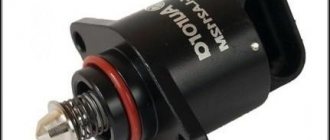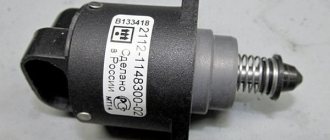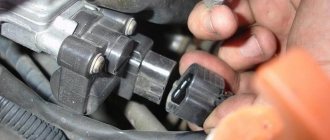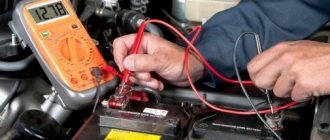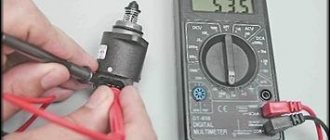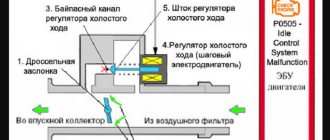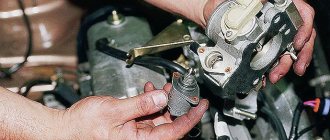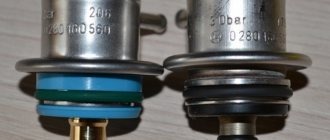- Lack of regular speed limits
- Engine light is on
- The engine starts to stall
To create safe conditions for driving a vehicle, you need to ensure that all components are in good working order. The idle speed control stabilizes the engine when idling. However, over time, the system may become unusable, which negatively affects vehicle control. In order to avoid emergency situations, it is advisable to find out what signs of breakdown exist and what to do in the event of a malfunction.
Operating principle and location of the IAC
Briefly, everything happens as follows. When the engine is idling, a certain amount of air enters it, which allows it to function smoothly.
DPKV takes into account the number of revolutions, this data is sent to the control unit, from which a command is given to the IAC to reduce or increase the air supply. Which he does, ignoring the closed throttle.
IAC device: 1) valve; 2) regulator body; 3) stator winding; 4) lead screw; 5) plug terminal of the stator winding; 6) ball bearing; 7) stator winding housing; rotor; 9) spring.
If the engine warms up to operating temperature, the controller automatically begins to maintain idle speed. If the engine has not heated up to the required degree, then the controller itself will increase the speed due to the IAC, thereby ensuring the engine warms up at higher speeds. This mode of engine operation allows the car to start moving immediately, without warming up.
Where is the idle air control valve located? Yes, in the throttle body - it is secured there with two screws. There are cars on which the heads of the mounting screws can be drilled out or the screws themselves are set on the varnish, which, of course, can significantly complicate the replacement or cleaning of the IAC air duct. In such cases, it is extremely difficult to do without dismantling the throttle body.
Currently, automakers use the following types of idle air regulators:
- solenoid;
- stepper;
- rotary.
Let's look at each of the listed types in more detail.
The idle speed control solenoid operates using electromagnetic force. So, when voltage is applied to its coil, the core is retracted, and the damper mechanically connected to it rises, thereby opening the air channel. When the voltage is lost (that is, the solenoid is turned off), the damper returns to its place, closing the channel.
Adjustment of the operation of the solenoid IAC is carried out by changing the frequency of command signals to the actuator. In order to pass a precisely measured amount of air through itself, high-frequency signals are sent to the working element. This allows air to be supplied in small portions.
The stepper idle speed controller has a ring magnet in its design, as well as four electromagnetic windings. Voltage is applied to them alternately, thereby creating a rotating magnetic field that causes the control rotor to rotate. It is connected to an actuator, which locks or unlocks the air channel.
As for rotary idle speed controllers , they are controlled using frequency pulses. The operating algorithm is similar to the solenoid type, however, instead of a solenoid, in this case a rotor is used.
Idle air control malfunctions
Like any other part, the IAC is not immune from breakdowns. In this case, the signs of failure are in many ways similar to those that arise when there are problems with the throttle position sensor. Only, unlike the TPS, an error notification (check engine) will not appear, since the XX regulator is an executive device.
A malfunction of the IAC can be judged by the following signs:
Broken electrical wiring on IAC
- Unstability of engine speed at idle, in some cases engine shutdown (if the speed is not maintained using the accelerator pedal).
- Decrease or increase in speed for no reason.
- A complete stop of the engine when the gears are engaged or when the car is moving away.
- During a cold start, the engine does not operate at high speeds.
- A drop in engine speed at idle when the headlights or heater are turned on.
Next, we will consider the reasons for the malfunction of the idle air regulator. There are only two of them:
- natural wear of the regulator needle guide;
- broken electrical contacts inside the regulator housing.
Methods for self-diagnosis of DCC
You can get the most accurate results of studying the operation of the XX regulator on a special stand that simulates the operation of the ECU and can interpret the results obtained. However, the average car enthusiast cannot afford to have such a device, and such a check at a car service center is not a cheap pleasure. Therefore, less expensive techniques are used, the general algorithm of which is approximately the same and includes the following steps:
- the car is placed on a level surface, secured with wheel chocks and a hand brake;
- the negative terminal is disconnected from the battery;
- The regulator is disconnected from the ECU (the plug is pulled out of the connector).
Subsequent actions depend on the diagnostic methods used.
Manual check of IAC status
This is the easiest and fastest way to determine the functionality of the sensor if there are indirect signs of problems with the functioning of the electronic intake control system, but this method will require an assistant. Algorithm of actions:
- dismantle the device (in most cases by unscrewing two screws);
- The IAC is again connected to the on-board computer, being in the hands of the person performing the diagnostics;
- At this time, the assistant starts the motor, and the inspector observes whether the actuator rod is completely retracted into the housing, and whether it extends a certain distance after receiving the next control impulse from the computer;
- If the sensor rod has no defects and moves back and forth properly, you should look for another cause of the malfunction.
How to check the idle air control
Based on these symptoms, we can conclude that the idle air control valve needs to be checked. There are several methods.
Checking with a multimeter
Several ways to check IAC
The most famous way. First you need to turn off the ignition and disconnect the harness plug from the regulator. Then use a multimeter to measure the resistance of the windings. If between C and B, A and D shows an open circuit, do not worry, this is how it should be. But between A and B or C and D, the resistance should be in the range of 40-80 Ohms.
Checking with a homemade tester
On injection cars, checking with a multimeter is of little use. Often, the breakdown of the IAC lies in the fact that the regulator is stuck in the open or closed state.
If this turns out to be the case, then a homemade tester will do, which you can make yourself from a 6V AC transformer (suitable from a regular mobile phone charger). When playing with switches, you should check the stroke of the idle air control rod . If the rod is working properly, the light will barely glow, but a bright light indicates that the rod is stuck somewhere.
Visual inspection
The simplest and, perhaps, first-priority diagnosis is a visual examination. It is carried out after dismantling the unit from the seat. A visual inspection can reveal body defects, needle wear, or other defects visible to the eye. However, if during such an inspection you identify damage, you cannot stop only at this stage. It is necessary to continue checking to identify possible causes of failure.
If, after performing a visual check, you find significant contamination of the housing or internal volume of the regulator, we recommend that you clean it. Moreover, regardless of whether the IAC is in good or faulty condition.
IAC and throttle valve
Let's sum it up
As you can see, the idle speed sensor is an important and critical part in the ECM of a car engine. It is important to understand that the IAC is an electromechanical solution, that is, problems can arise in the electrical or mechanical parts.
We also recommend reading the article about what ELM327 is, what features the ELM327 scanner has, how this solution works and what functionality is available. From this article you will learn about the advantages of the ELM327 scanner, as well as what to look for when choosing this device before purchasing.
In this case, it is important that the sensor works correctly, that power is supplied to it, and that the ECU commands are carried out by the regulator accurately and in a timely manner. For this reason, it is necessary to check the electrical circuits, contacts and connectors, as well as the quality of operation of the regulator needle itself and other sensor elements.
Removing/replacing IAC
Let's take a closer look at the process of dismantling and replacing the idle air control. It is worth immediately noting that on different cars the process may differ in some details, but in general the algorithm will consist of the following stages:
- All work must be performed with the engine turned off. It is also advisable to disconnect the negative terminal from the battery.
- Disconnect the connector (chip) of the contact going to the regulator.
- Unscrew the mounting bolts that secure the regulator body. At the same time, make sure that the unscrewed bolts do not fall into the engine compartment.
- Remove the regulator directly from its seat.
Installing a new regulator is performed in reverse order. However, before installation, it is necessary to lubricate the flange O-ring with engine oil. The brand in this case is not important, the main thing is that it is non-aggressive towards rubber. Also check the distance from the flange to the extreme point of the cone needle. It should be 23 mm . Such a gap is needed so that when installing the IAC, its conical needle cannot rest against the seat on the throttle body. The gap value can be adjusted using a special multitester or control pulse shaper.
Carrying out a visual inspection, cleaning the IAC
Even an inexperienced car owner can carry out this procedure independently. It is enough to perform the following steps step by step:
• Check access to the valve. Look at the technical manual, which should be present for each specific model.
• Disconnect the valve. Find the electrical connection and turn off the idle valve.
• Remove the valve from the vehicle. Follow the instructions in the technical manual. This will help you quickly dismantle.
• Check the idle valve. Make a visual inspection of the structure itself and the installation site. There should be no accumulation of carbon, dust and dirt or corrosion. Also, the pin should not have mechanical damage.
Attention: It is strongly recommended not to use wire or metal brushes. Otherwise, the function of the valve may be affected.
• Install the valve. When installing a new part, it is necessary to include a gasket. Some manufacturers already include the part in the kit. This will help reduce the loss of coolant passing through the valve body.
• Start the engine. If a large amount of cleaning agent is used, the engine may operate with slight irregularities. However, after a short period of time everything should stabilize.
At this point the procedure can be considered complete. It is important to note that after visual inspection for mechanical damage, it is important to check the valve resistance. This will help determine whether the part is working or whether it is necessary to replace it with a new valve.
How not to fall for a fake when choosing an IAC
If the check shows that the regulator is broken, you should be prepared to replace it, which was mentioned just above. If we talk about IAC on VAZ, then the idle speed controllers OMEGA and KZTA (Kaluga) stand out in terms of quality and reliability. Of course, we are talking about original parts, not fakes.
You can identify a fake IAC by the box in which it is packaged. Cheap packaging, strange font, bad, smudged printing - all this indicates a fake.
The fake part itself also has flaws. As a rule, this is play in the guide bushing and the cap itself. Over time, the backlash only increases, which negatively affects the operation of the IAC. In addition, there may be a gap on the regulator body, due to which air leaks will appear. Poor soldering of the contacts is also possible.
You can protect yourself from counterfeiting with the help of the manufacturer himself, who applies protective measures. This may be a unique spare part code, which can be verified via SMS or on the website.
Video about the sensor
Recommended viewing:
- Idle speed regulator Niva, 2121/2123, Chevy
- Idle speed sensor Lada Priora
- Idle speed regulator VAZ 2115: Replacement and check
- Idle air control Lada Kalina
- Description of the idle speed regulator for VAZ cars
- Idle speed floats: Causes and solution
Category: Sensors
← All injector sensors Mitsubishi Lancer 9
Lambda probe Lada Kalina: Purpose, Location, Error →
